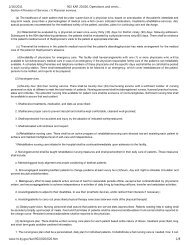State Regulations Pertaining to Dietary Sanitation & Environmental ...
State Regulations Pertaining to Dietary Sanitation & Environmental ...
State Regulations Pertaining to Dietary Sanitation & Environmental ...
Create successful ePaper yourself
Turn your PDF publications into a flip-book with our unique Google optimized e-Paper software.
(4) Rodent bait must be contained in covered, tamper-resistant bait stations.<br />
(5) Tracking powder pesticide may not be used in a food service establishment. A non<strong>to</strong>xic tracking<br />
powder such as talcum or flour may be used, but may not contaminate food, equipment, utensils,<br />
linens, and single-service articles.<br />
(6) Openings <strong>to</strong> the outside must be effectively protected against the entrance of rodents. Outside<br />
openings must be protected against the entrance of insects by tight-fitting, self closing doors, closed<br />
windows, screening, controlled air currents, or other means. Screen doors must be self-closing, and<br />
screens for windows, doors, skylights, transoms, intake and exhaust air ducts, and other openings<br />
<strong>to</strong> the outside must be tight-fitting and free of breaks. Screening material must not be less than 16<br />
mesh <strong>to</strong> the inch.<br />
(1) Cleaning of floors and walls, except emergency cleaning of floors, must be done during periods<br />
when the least amount of food is exposed, such as after closing or between meals. Floors, mats,<br />
duckboards, walls, ceilings, and attached equipment and decorative materials must be kept clean.<br />
Floors and walls must be cleaned by dustless methods, such as vacuum cleaning, wet cleaning, or<br />
the use of dust arresting sweeping compounds with brooms.<br />
(2) In new or extensively remodeled establishments at least one utility sink or curbed cleaning<br />
facility with a floor drain must be provided and used for the cleaning of mops or similar wet floor<br />
cleaning <strong>to</strong>ols and for the disposal of mop water or similar liquid wastes. The use of hand washing<br />
facilities, utensil washing or equipment washing, or food preparation sinks for this purpose is<br />
prohibited.<br />
(3) When service sinks are used as a hand washing facility, such sinks must be located <strong>to</strong> prevent<br />
potential contamination of food or food contact surfaces of equipment and utensils.<br />
NEBRASKA<br />
Downloaded January 2011<br />
12-006.11E Sanitary Conditions: The facility must comply with the provisions of the Food Code.<br />
NAC 449.74525 <strong>Dietary</strong> services. (NRS 449.037)<br />
8. A facility shall:<br />
NEVADA<br />
Downloaded January 2011<br />
Page 57 of 74



